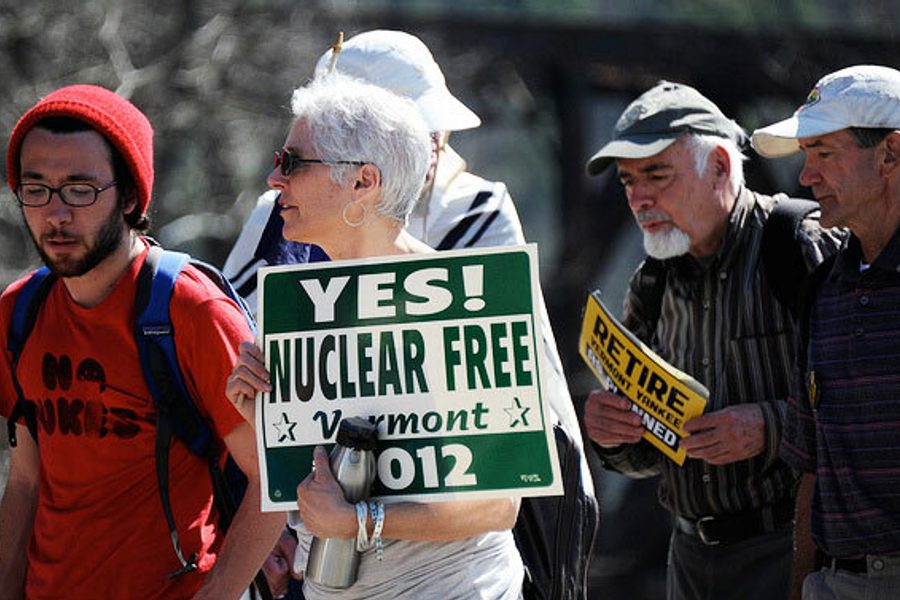Vermont Yankee: A Nuclear Battle Over States’ Rights
There’s no end in sight to Vermont’s long-running legal struggle to shutter an aging power plant.
John Raymond

It was a 40th birthday bash attended by more than 1,000 people in three states – but the attendees came to demonstrate, not celebrate. The Vermont Yankee nuclear power plant, a poster child for anti-nuclear protests throughout its four-decade history, was the target. Only the day before, on March 21, its state permit to operate expired and the legislature voted to shut it down. But the power plant was still operating.
The protest brought demonstrators (“Hell no, we won’t glow”) to Vermont Yankee’s owner, the Entergy Corporation, and its offices in Brattleboro, Vt., White Plains, N.Y., and corporate headquarters in New Orleans. There, they put up a yellow crime tape outside the building and went inside to demand an interview with CEO J. Wayne Leonard.
In a statement, Entergy said it was “business as usual for our employees, who are focused on providing safe, clean and affordable electricity.”
Vermont’s legal battle to shut down the Yankee power plant is on the radar screen in states throughout the country where local communities are fighting the relicensing of aging nuclear sites. Citizens are concerned by ongoing radioactive leaks that contaminate groundwater, shutdowns resulting from degrading systems and lax maintenance, and fears that corporate owners won’t pay the near $1 billion price tag to decommission plants.
Entergy’s Vermont Yankee plant in Vernon, on the Connecticut River, its Indian Point plant on the Hudson River outside New York City, and its Pilgrim nuclear plant on Cape Cod Bay in Plymouth, Mass., are all at the center of fierce battles aimed at shutting the plants down. But in recent months, the Vermont Yankee battle has taken center stage.
In January, a federal district judge upheld Entergy’s challenge to Vermont laws adopted in 2006 (and agreed to by Yankee) that give the state legislature veto power over approving a federal license extension for the Yankee plant. In 2010, the Vermont Senate overwhelmingly (26 to 4) rejected allowing the plant to operate beyond its 40-year federal operating license.
Last year, despite the state’s opposition, the Nuclear Regulatory Commission (NRC) approved a 20-year license extension – but NRC chairman Gregory Jazco said he would not interfere with Vermont legislators’ decision. A month later, Entergy took Vermont to court.
In a controversial decision that raises issues of states’ rights to address nuclear issues within their borders, federal judge Charles Murtha ruled that Vermont’s laws were pre-empted by federal law – the Atomic Energy Act (1954) – that puts nuclear safety issues under the sole jurisdiction of the Nuclear Regulatory Commission.
Murtha said the legislative record showed that safety was the state’s main concern in passing the legislation. The record contained instances “almost too numerous to count” that “reveal legislators’ radiological safety motivations and reflect their wish to empower the legislature to address their constituents’ fear of radiological risk,” according to the judge’s ruling.
Vermont officials, well aware of federal pre-emption on nuclear safety issues, have stated that the legislation – which makes no reference to “safety” – was adopted because of concerns about the reliability of the Yankee plant going forward. But they’ve also said that the plant does not fit into the state’s long-term planning for sustainable energy or serve the public good.
“It is inconceivable to me that Entergy can force Vermont to allow continued operation of Vermont Yankee, an aging and problem-plagued nuclear plant, when the people of Vermont want to move aggressively to energy efficiency and sustainable energy,” Vermont Sen. Bernie Sanders said in January.
Gov. Peter Shumlin, who took office in January 2011, campaigned on shutting the plant down. “Entergy has not been a trustworthy partner with the state of Vermont,” Shumlin said in a statement after Murtha’s ruling. “I continue to believe that it is in Vermont’s best interest to retire the plant.
‘It’s rare for a state to act this way’
Both Vermont and Entergy have appealed Murtha’s ruling to the 2nd U.S. Court of Appeals in New York. Entergy is challenging Murtha’s upholding of the role of the Vermont Public Service Commission, which must issue a state permit for continued operation of the plant. The current permit is now expired; hearings on a new permit are entangled in legal proceedings.
The vote in 2010 to shut the plant came in the wake of a few well-publicized incidents: the collapse of a cooling tower in 2009 and a tritium leak the following year. The leak created an underground plume that reached the Connecticut River where water containing radioactive tritium was found in samples taken in August and November last year.
The leak also revealed that plant officials had earlier made “misstatements” under oath when they testified before state boards that the plant had no underground pipes that carried radioactive effluent. The leak proved otherwise.
Contributing to the no-vote were suspicions aroused when Entergy, in the months following the collapse of the cooling tower, proposed spinning off Vermont Yankee and five of its other aging plants, including Indian Point and Pilgrim, into a new and highly leveraged holding company. It would have had no assets except the six plants, which all required heavy investment. The NRC approved the plan, but it didn’t give the regulatory approval it needed in New York, and Entergy subsequently dropped it.
“Legislators and opponents saw the proposal as a shell game, an effort to avoid the liability of paying for plant decommissioning by creating an under-funded and debt-ridden new entity, keeping the more valuable assets with Entergy,” writes Richard Watts, an assistant research professor at the University of Vermont, in a new book, Public Meltdown: The Story of the Vermont Yankee Nuclear Power Plant.
In an interview, Watts said Vermont’s vote to shut down the Yankee plant was an uncommon action. “It’s rare for a state to act this way,” he said, noting that the last time a similar action occurred was in 1989, when a successful state ballot initiative shut down the Rancho Seco nuclear plant near Sacramento. That ballot drive was led Ben Davis, who is currently leading a new initiative underway in California to shut down the San Onofre and Diablo Canyon nuclear plants.
The big question raised by the Vermont Yankee battle, Watts says, is: What is the role of states in overseeing the nuclear power plants within their borders?
“Traditionally, states have had oversight on a whole range of issues now at stake in this case – economic benefits, the role of a nuclear plant in a state’s energy planning, waste disposal, land use and water discharge issues. Those are all at issue here,” he said.

I hope you found this article important. Before you leave, I want to ask you to consider supporting our work with a donation. In These Times needs readers like you to help sustain our mission. We don’t depend on—or want—corporate advertising or deep-pocketed billionaires to fund our journalism. We’re supported by you, the reader, so we can focus on covering the issues that matter most to the progressive movement without fear or compromise.
Our work isn’t hidden behind a paywall because of people like you who support our journalism. We want to keep it that way. If you value the work we do and the movements we cover, please consider donating to In These Times.






